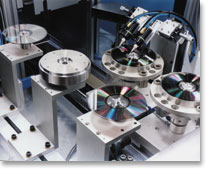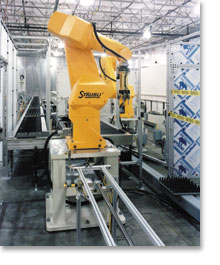
In today's manufacturing scene, companies must cut time to market to stay ahead of the pack. No matter how good a product, it will be all for naught if the company can't deliver the product to market before the competition. Being the first to market increases a company's profit margin, as well as its market share, but being late limits pricing flexibility, squeezes profit margins and curtails the manufacturer's ability to compete within a particular market segment.
Introducing a new product can be a time-consuming process, with many phases to be completed before the product can head out the door. But first, the manufacturer must devise product specifications. Then the next critical step is to send out requests for quotes (RFQs) to vendors. Developing an RFQ that accurately reflects an automated assembly project's requirements is critical to selecting the appropriate vendors. Even when manufacturers have strategic partnerships with key machine builders, detailed RFQs can help speed up the selection process by limiting misunderstanding of requirements and reducing the need for long negotiations or rework later in the development cycle.
A sound RFQ ties the manufacturer and vendor to one document, while eliminating surprises for either party. The RFQ ensures that both the manufacturer and vendor understand what is expected from the time of quotation through installation.
There is no standard way to write an RFQ. Some customers give verbal specifications, while others only write a half-page description. However, the best RFQ has plenty of details.

How Much Detail?
How much detail an RFQ should contain depends on whether the RFQ is for budgetary purposes or if it is for a firm proposal. If it is for a budgetary requirement, less detail is needed.
It is not wise to waste a vendor's time by asking for a detailed proposal for a project that is budgetary. This may damage the manufacturer's credibility in the automation vendor's eye. Instead, tell the vendor up front that the RFQ is for budgetary purposes. It will make the proposal time quicker, and reputable companies will give it the same amount of credence. They just won't go into the same level of detail and expend an extreme amount of time.
However, if the manufacturer has an allotted capital budget and the process is well-defined, as much detail as possible should be provided. For this situation, most machine builders agree that a vague RFQ is always troublesome.
A properly written RFQ needs a good process definition and should explain what the manufacturer is trying to accomplish. It should also clarify the manufacturer's specifications; the controls that need interfacing; the procedures that need to be matched up with; and the project's end result.
In detail, RFQs should explain the following: definition of purpose; equipment description; product specifications; piece part specifications; equipment output rates; output efficiency; sequence of operations; facility requirements; safety requirements; interface requirements; equipment construction guidelines; control system requirements; training requirements; testing and acceptance procedures; installation requirements; documentation requirements; quotation requirements; input and output list; and equipment schedule.
In addition, the RFQ should contain any environmental requirements; any special regulations, such as clean room requirements for chemical, pharmaceutical or electrical processes; and any FDA regulations.
For instance, the medical device industry uses a standard for equipment called good manufacturing practices. If the equipment is for the electronics industry, the RFQ should note whether Surface Mount Equipment Manufacturers Association standards are to be followed. Many times, these are just noted in a small reference in an RFQ, and they end up being a very big piece of the job.
Revising an RFQ
The RFQ phase is the front end of the capital equipment acquisition process, so there is always room for alterations to the plan. The decision process is always on the customer's end. However, most machine builders state that they like to get involved early in the process, even helping describe the process in the RFQ.
Manufacturers would be well-advised to select the vendor early and then consult with that vendor on manufacturability issues. If you're going to spend a half million dollars on molds for plastic parts, you might as well spend that half million on parts that can be assembled easily by automatic means. Because the product designer is concerned with the product's function much more than the automatic assembly of the product, he is much less expert at automatic assembly. This can mean the difference between something that is easily assembled or difficult to assemble.
Every company handles RFQ revisions differently. The automation industry is notorious for quoting low to get the job and getting even with the adders. If the changes to the RFQ are small, then the vendor should try to absorb the cost of the change. However, if it's a change in scope that is beyond what was quoted originally, the manufacturer should expect to be quoted a higher price.
During negotiations, engineers will identify additional needs or eliminate things that aren't as critical as assumed. Therefore, it is beneficial to allot time for slight changes to the RFQ or the manufacturing process. RFQs will go through revisions, just like the vendor's proposal will go through revisions.
Evaluating Quotes
There is no substitute for a visit to the automated equipment vendor. This gives the manufacturer the opportunity to talk to the vendor's staff to get a good idea of who they are. If you walk into a place and it's sloppy, you can bet that the company's organization is sloppy and that your project will be sloppy.
Although cost and delivery may seem to be the deciding factors during the selection process, technical ability and performance are actually the most important. If the vendor cannot provide the equipment due to unfamiliarity with a manufacturer's processes, the manufacturer cannot assemble and sell the product.
Automated equipment vendors should also pass these other criteria:
- What is the company's on-time delivery record? The vendor should detail its delivery record for the past three to four years.
- How skilled is the company at project management? The difference between a good project and a bad project is almost entirely the level of skill at project management.
- The vendor should also provide reports and timetables.
- Vendors should provide references. If they don't have a long list of references, that should raise questions.
- Does the vendor have any experience in your industry or with your processes? However, companies that have similar experience that is applicable to the manufacturer's project shouldn't automatically be ruled out.
- Investigate the vendor's financial stability. If a company is unwilling to provide financial information, be suspicious.
- After-delivery support or warranty should be addressed. If they are not willing to stand behind something they produce, there is a reason for that.
- Inquire about documentation and programming. Customers should get complete bills of materials and spare parts lists with actual original equipment manufacturer numbers so the parts can be bought directly from the suppliers. All the program listings and detailed drawings should be acquired, so if a part breaks, a new one can be machined locally. Additionally, never base a machine builder's capabilities on one performance. Performance can vary from project to project.
Despite the effort that a manufacturer may put into developing an RFQ, there is seldom a clear winner in the vendor evaluation race. Providing the correct amount of information and details will increase the manufacturer's odds of choosing a suitable automation partner. This final choice should be made with in-depth knowledge of the vendor's strengths and weaknesses. To assure success, the manufacturer and the vendor should have all the key skills and work as a team.
What's the Internet's Role in the Future of RFQs?
Thousands of companies, large and small, build machinery. The Internet can initially help an engineer wade through this sea of machine builders. But will its role in the RFQ process advance much further?
Many of the larger and more established equipment builders have websites that describe their companies and show pictures of machinery and installations. Those websites often contain RFQ pages that allow a potential customer to input information and receive an estimated quote in a couple of days.
However, most assembly system manufacturers believe that the Internet won't advance the RFQ process much further than simply providing an avenue for preliminary selection. Because equipment is customized and the products are increasingly not as well defined when getting automation, it works against streamlining the process.
The Internet's promise as a means of communication also seems limited. Many vendors stated that any time they tried to decrease or streamline the amount of communication, it's led to problems. To put it simply, there is too much communication that has to take place, too many questions and too many options. In the end, a face-to-face meetings is still the way to go.

